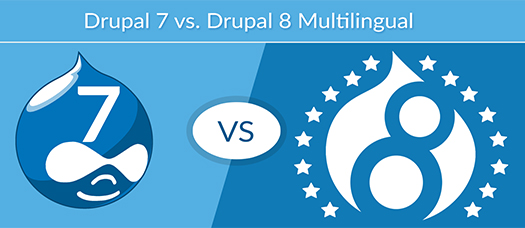Major Differences between Drupal 7 and Drupal 8
There are dozens of open source CMS freely available online like WordPress, Drupal, Joomla etc. that can be downloaded by users, various open source CMS have advantages and disadvantages and thus users can select the CMS they need to install depending upon their specific needs. Drupal is one of the widely used Content Management Systems.
Drupal
Drupal is a free and open source CMS basically written in PHP and is being used by at least 2.1% of all websites globally, though it offers a sophisticated application programming interface for developers however no programming skills are required for basic installation and administration. Drupal is considered as one of the most powerful content management system for building websites as it is less resource intensive as compared to WordPress and thus can be easily used from a simple blog used by individual users to a content portal used by large corporations.
Advantages of Drupal
- Drupal is one of the most technically advanced content management system and thus you don’t have to worry about upgrading it to a more expensive option.
- Drupal is easy to customize according to individual needs with the help of many modules and themes readily available. With the help of knowledgeable developer you can also edit the file system and get it customized according to your specific needs.
- Drupal is open-source and thus can be downloaded and used for free.
- Drupal is more performant compared to WordPress and Joomla as Drupal pages typically loads faster.
- Since its initial launch, various versions of Drupal were released to make things better and easier for end users.
Drupal 7
Drupal 7 is a fantastic content management system however as every other content management system it also comes up with some limitations. Below are couple of limitations with Drupal 7 for your reference:
- Incomplete Entity API.
- Lack of separation between content and configuration in the Database.
- Lack of separation between logic and presentation in the theme layer.
- Another limitation of Drupal 7 was it is hard for organizations of all sizes to find Drupal talent (developers, themers, site builders, etc) and thus Drupal 7 was complex to use for many individuals.
Thus with the launch of Drupal 8 these limitations were taken into consideration and a very good amount of work has been done on Drupal 8´s mobile features and user experience improvements. At the same time the above mentioned issue of Drupal 7 being complex for many individuals were taken care with the launch of Drupal 8 as the code will be more abstract, verbose yet it will also be more maintainable and accessible to non Drupal developers.
With Drupal 8, developers feel that they have to relearn everything since Drupal 8 is based on the Symfony PHP Framework and the twig templating system. Drupal 8 is based on Object Oriented Programming which is a dramatic change from Drupal 7.
Advantages of Drupal 8
- Drupal 8 is still Drupal and thus it fits all size or type of organizations starting from hobbyists to large government entities and fortune 500 companies.
- Dedicated support is provided for Drupal 8 users with simple documentation available to understand the new features/changes.
- Drupal 8 comes with more robust new configuration management system and is compatible with mobile devices and thus it overcomes the limitations of Drupal 7 regarding mobile devices.
- The pages of Drupal 8 are HTML 5 based and thus Each output template has simplified elements and classes with native input tools for mobile fields like date, email and phone.
- Drupal 8 has inbuilt multilingual feature and thus you can easily translate anything in the system using built in user interface and thus its awesome for building multilingual websites and this feature will benefit both end users and developer and reach greater audiences on both sides.
- A new tool bar is introduced in Drupal 8 with top level items including: Home, menu, shortcuts and users.
- Drupal 8 is more accessible as compared to Drupal 7 specifically benefiting visually impaired users.
- Drupal 8 provides and support inline editing by using spark project, this spark project was introduced in Drupal 7 version and acted as an incubator for Drupal 8.
To check and compare the features of Drupal 7 and Drupal 8 I had personally downloaded the different versions and was disappointed to find that with Drupal 8 the performance regression was between 50% to 70% and thus I still believe that Drupal team still need to do a better job to deliver a really fast Drupal 8.
Disadvantages of Drupal (My Personal Opinion)
Every CMS comes with advantages and disadvantages and the same is true with Drupal. below are couple of disadvantages of Drupal: (Of course , many developers would disagree with me.)
- Installing Drupal and making modifications in Drupal is not as easy as compared to other content management system like Joomla and WordPress.
- Drupal comes with limitations when it comes to future scalability and efficiency as compared to other content management systems like quick CMS and WordPress as when your website gets bigger, the code will generate a big server load. This is caused by the big range of possibilities provided by Drupal. There are however modules that load the website to the server’s cache, that decreases the server load.
References | Other Excellent Articles
- What are the main differences between Drupal7 and Drupal8?
- Drupal 8 Has All the Hotness, but So Can Drupal 7.
- Drupal 8.0.0-rc1 released.
- Drupal 8: Make something amazing, for anyone.
Conclusion
This post highlights the major differences between Drupal7 and Drupal8. I also listed in the References section other excellent posts relating to this topic. I encourage you to check them out.

